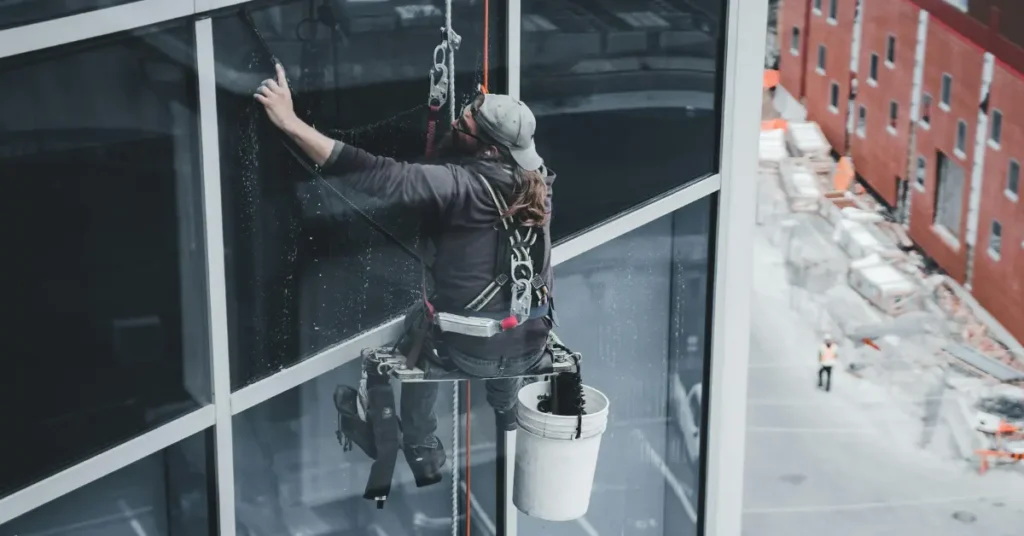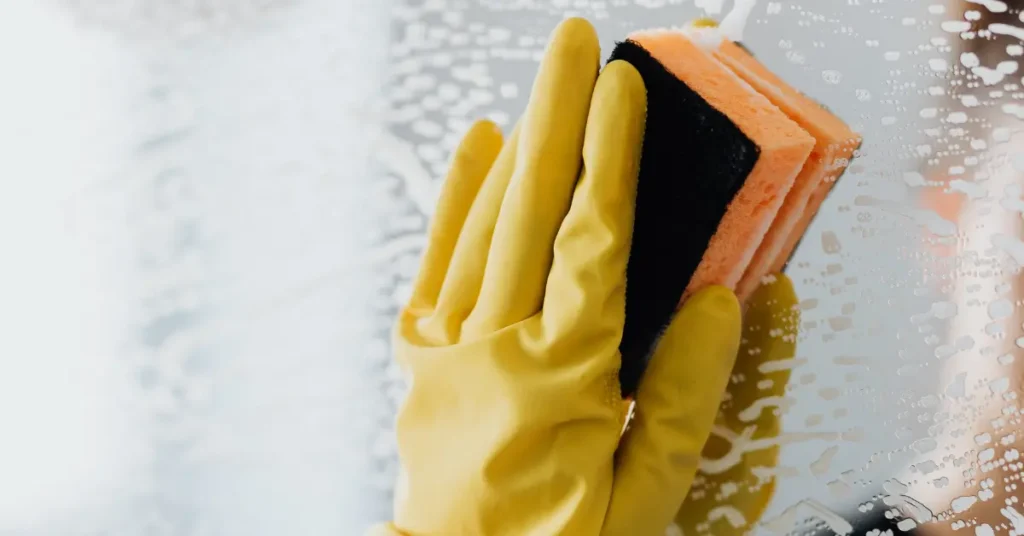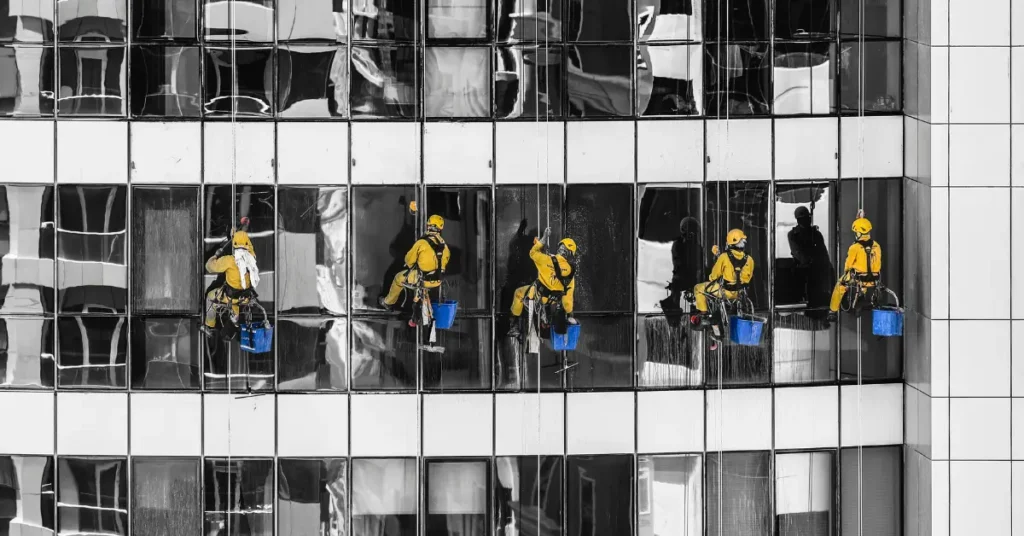Maintaining pristine building exteriors is a priority for property owners and managers, and one of the most visible aspects of exterior upkeep is window washing. Gleaming windows not only enhance the property’s curb appeal but also protect its long-term value. In this comprehensive guide, we’ll cover the commercial window cleaning basics so you can keep your building’s glass façades shining and damage-free.
Why Clean Windows Matter for Your Building
Clean windows are an integral part of maintaining a building’s appearance and image. Sparkling glass creates a positive first impression for tenants, customers, and visitors. Streaky or grimy windows can signal neglect. Regular exterior glass washing removes dust, water spots, and pollution before they become permanent blemishes on your glass. This upkeep is a crucial component of building exterior cleaning, as glass surfaces, if left dirty, can suffer from degradation. Neglecting window cleaning can block up to 20% of natural sunlight from entering a building, leading to a dimmer, less inviting interior. Natural light boosts occupant mood and productivity, so dirty windows can affect the comfort and efficiency of those inside. Additionally, removing corrosive contaminants is key to glass maintenance. Clean windows contribute to healthier indoor environments by preventing the accumulation of dust and mildew that can impact indoor air quality.
Understanding How to Clean High-rise Office Windows
Cleaning the windows of a multi-story commercial facility is a different challenge than wiping a ground-floor shop window. Commercial window cleaners must account for larger surfaces, greater heights, and persistent grime from urban pollution or weather. One fundamental difference in commercial window cleaning basics lies in the equipment and expertise required. For low-rise structures, the work might be done from the ground or using ladders; for taller buildings, it often requires special platforms or rope access. Commercial cleaning crews adhere to safety regulations and carry insurance, since the risks are higher when dealing with large structures. Whether performed by a dedicated high-rise window cleaning company or a general commercial one that offers window washing, the goal remains the same: crystal-clear glass with no streaks, spots, or hazards left behind.
Tools and Techniques for Effective Window Washing
Effective professional window cleaning relies on the right tools and techniques to achieve a streak-free shine on exterior glass. For ground-level and mid-level windows, technicians often use the traditional combo of a scrubber and a quality squeegee. These basic tools, along with a bucket of specialized glass cleaning solution, can remove most dirt and grime. Microfiber cloths or lint-free towels are then used to wipe the edges and catch any drips, ensuring no watermarks are left. Modern innovations have enhanced this age-old process; for example, water-fed extension poles enable cleaners to work from the ground on buildings several stories high. These systems pump purified, de-ionized water through a brush head, scrubbing the glass and rinsing it spot-free. This approach not only eliminates the need for ladders in many cases but also avoids chemical run-off by using pure water.
For mid-rise and high-rise properties, common solutions include facade cleaning platforms or boom lifts that can elevate workers to the required height. These mechanical platforms, often attached to the roof or building parapet, enable cleaners to cover wide sections of the facade efficiently. Rope descent systems are another technique, advantageous when a building’s design or roof can’t accommodate a suspended platform. Regardless of the method, using proper techniques is essential for achieving results. Cleaners typically work from top to bottom so that dirty water doesn’t drip onto areas already cleaned, and they may use overlapping squeegee strokes to avoid streaks. They also pay attention to details such as scrubbing window corners and frames, and ensuring the cleaning solution’s formula suits the glass type. By combining traditional know-how with advanced tools, exterior glass washing professionals can leave even expansive glass facades looking immaculate.
Scheduling and Frequency for Exterior Glass Maintenance
The frequency at which your building’s windows should be cleaned depends on several factors, including location, climate, building height, and the type of business. When building facade cleaning tips, consider increasing the cleaning frequency for windows in high-traffic or high-pollution areas. For instance, a downtown office tower near busy roads or construction sites may accumulate grime more quickly and benefit from monthly cleanings, whereas an office building in a cleaner suburban area might suffice with quarterly cleanings. Many commercial window cleaning experts advise a baseline of two to four professional cleanings per year for most commercial properties, adjusting up or down based on local conditions. This often means scheduling washes in spring and fall as part of regular glass maintenance with additional touch-ups in between if needed.
A proactive schedule yields multiple benefits beyond just appearance. By cleaning regularly, you prevent contaminants from sitting on the glass for months and causing damage. Consistent window maintenance helps to prolong the life of your windows by stopping the etching and corrosion that accumulated dirt and mineral deposits can cause. Clearing away debris and hard water spots before they harden means you’ll face fewer issues like glass staining, scratches, or degraded seals over time. Regular cleaning also makes each session easier and faster. Here are some additional tips to keep in mind:
- Account for the environment: If your building is near the ocean (salt spray), a highway (vehicle exhaust), or lots of trees (pollen and sap), schedule more frequent window washings. Likewise, after events like sandstorms or heavy pollen fall, an extra cleaning is wise.
- Choose optimal timing: Plan major cleanings for milder weather if possible. Cleaning during very hot weather can cause solutions to dry too quickly and streak. Many managers schedule exterior window work for overcast days or cooler morning hours for best results. Also, consider an extra cleaning after any construction or painting work on or near the building to remove overspray or dust.
- Don’t neglect deep cleaning: In addition to routine washes, arrange for periodic facade cleaning of the entire building every few years. For example, pressure washing the exterior walls every 5-7 years can prevent runoff from dirty masonry or metalwork from streaking your windows. Resealing windows and facade materials as recommended will also protect against leaks and staining.
- Monitor and adjust: Keep an eye on your building’s windows over the seasons. If you notice they’re getting dirty faster than expected, change the schedule accordingly. Some glass, like that on the shaded sides of a building, might stay clean longer, while other areas may need extra attention.
By implementing a structured cleaning schedule, you ensure your building always looks its best and avoid the pitfalls of neglect. The correct frequency will keep your windows clear, minimize long-term damage, and ultimately save money by extending the intervals between expensive restorative cleanings or glass replacements.
Step-by-Step Process for Exterior Glass Maintenance
Even if you hire professionals for window cleaning, it’s helpful to understand the general step-by-step process. Adhering to proper procedure ensures a thorough, safe, and efficient job. Below is a breakdown:
- Assessment and Preparation: Evaluate the building and windows to determine the best cleaning method for the situation. This includes identifying window types, any problem spots, and the required access method. Inside preparations are important too: if windows will be cleaned from the inside or opened, protect interior floors and furnishings with drop cloths. Outdoors, set up safety signage or barriers on the sidewalk below if working above ground level. This planning step ensures the team has the right tools on hand and that building occupants are informed of the work to avoid surprises.
- Gather Tools and Cleaning Solution: Before starting, assemble all necessary equipment. For most jobs, this will include buckets, a cleaning solution, scrubbers or brushes, squeegees of appropriate size, extension poles, and plenty of clean microfiber cloths. If using a water-fed pole system, ensure the water purification filter is working and the hoses/brush heads are in good condition. Check that any ladders or lifts are stable and certified, or that rope gear and anchors are correctly set. By staging all tools conveniently, cleaners can work without unnecessary interruptions.
- Safety First: Prioritize safety measures before the actual cleaning begins – this is non-negotiable, especially for multi-story work. Crew members should wear their PPE, including gloves for hand protection and a better grip, safety goggles to guard against splashes, and harnesses for any work above ground level. If using a suspended scaffold or rope descent system, double-check all connections, harness buckles, and rope integrity. A “buddy system” is wise: have at least one person on the ground or roof acting as a spotter or backup. For ground-level work, ensure the area is cordoned off to prevent pedestrians from walking under ladders or falling water. Taking time with these precautions sets the stage for an incident-free operation.
- Cleaning the Glass: With prep done, the actual window cleaning services begin. Remove any loose dirt or dust from the glass. This can be achieved by quickly wiping with a dry cloth or brush, or by spraying with water to prevent the cleaning solution from creating mud. Next, apply the cleaning solution uniformly across the pane. Professionals often use a t-bar applicator or a soft brush to scrub the entire glass surface gently, paying special attention to corners and edges where grime tends to accumulate. For upper floors, this might be done via a brush on an extension pole or by hand from a scaffold. Once the dirt is loosened, it’s time to squeegee. Starting at a top corner of the glass, draw the squeegee in a straight stroke to the opposite side, then wipe the blade with a cloth. Continue in overlapping strokes from top to bottom to push the dirty water off the glass. The key is consistent pressure and angle to avoid streaks. For very large panes, the cleaner may break them into sections. When using the water-fed pole method, scrubbing and rinsing occur simultaneously: the brush scrubs while a stream of purified water washes away debris, which then air-dries without leaving spots.
- Detail and Inspect: After squeegeeing, some water will remain at the glass edges and on the frame. Use a clean, dry microfiber cloth or a rubber-tipped detail knife to wipe the perimeter of the window and the sill, catching any drips or residual moisture. This “detailing” step is what gives a truly streak-free finish. Inspect the glass for any streaks or missed spots by observing it from multiple angles and under good lighting conditions. If streaks are present, they can often be polished out with a dry microfiber or require an extra pass with a damp chamois followed by a dry wipe. Also, inspect for any stubborn deposits; if found, a scraper with a fresh blade can be used at a low angle to remove them.
- Cleanup and Maintenance Plan: Upon finishing the windows, properly dispose of or dilute any leftover cleaning solution and rinse out tools. Ensure no equipment or residue is left on the roof, ground, or fire escapes. It’s good practice to wipe down and dry tools like squeegees and brushes so they last longer and are ready for next time. Take note of any issues observed during cleaning. If you notice damaged caulking, cracked glass, or leaks, record it so building management can address these repairs. This step also involves reviewing the cleaning frequency: if windows were filthy since the last wash, consider scheduling cleanings more often. By planning ahead for the next service, you ensure that maintaining pristine windows is an ongoing effort, not a one-off event.
Following these steps methodically will result in windows that not only look great immediately but are set up to stay in good condition over the long term. Whether performing these tasks in-house for a low-rise building or overseeing a hired crew on a skyscraper, a structured approach to exterior glass maintenance is the best practice.
Scope of Window Cleaning Services
What is typically included in commercial window cleaning services, including interior and exterior cleaning, as well as additional related offerings? While some smaller jobs can be handled by in-house staff, most commercial properties will benefit greatly from hiring professional window cleaners. Engaging commercial window cleaning services brings specialized expertise and equipment that ensure a higher quality result and a safer process. Professional crews know the tricks of the trade to achieve spotless, streak-free glass quickly, and they come prepared with the right tools that a typical facility team won’t have on hand. Perhaps most importantly, they are trained in safety protocols for working at heights, meaning they won’t put themselves, your tenants, or your property at undue risk. A qualified team will be fully insured and follow industry standards, so the liability and compliance burdens are off your shoulders.
DIY vs. Professional Cleaning
When deciding between in-house window cleaning and hiring professionals, consider factors like safety, equipment, and expertise. DIY cleaning may suit low-rise, accessible windows, but often lacks the tools and training needed for high-rise or large-scale jobs. Professional services ensure thorough results, compliance with safety standards, and time savings for your team.
Customization for Different Facilities
The availability of customized cleaning solutions for businesses with unique requirements or multiple locations varies. Every business is unique, and commercial window cleaning providers recognize that a one-size-fits-all approach rarely delivers optimal results. For businesses with specialized requirements, such as sensitive environments or irregular window designs, professional cleaners can develop custom plans that account for access challenges, safety protocols, and preferred cleaning frequencies. Moreover, organizations with multiple locations benefit from coordinated service across all sites, ensuring consistent standards and streamlined scheduling. By working closely with clients to understand their operational needs and facility layouts, commercial window cleaning services can deliver flexible, scalable solutions that maintain spotless windows and a professional appearance everywhere. This customized approach not only enhances the look of each property but also simplifies management for businesses overseeing diverse or geographically dispersed facilities.
The Cost of Commercial Window Cleaning
Several important factors determine the cost of commercial window cleaning services. Window size plays a major role; larger or uniquely shaped panes require more time and specialized equipment. Building height also impacts pricing, as taller structures often need lifts, scaffolding, or rope access, increasing labor and safety requirements. Service frequency is another key consideration. Regularly scheduled cleanings may lower the per-visit cost compared to one-off jobs, as less buildup accumulates. Other variables, such as ease of access, total number of windows, and the presence of stubborn stains or hard water deposits, can also affect the final price.
Shining, well-maintained windows are the hallmark of a cared-for commercial building. Collaborating with experienced window cleaning professionals is the smartest route, providing peace of mind that the work is done correctly and safely. Keeping your building’s windows pristine is an investment in the property’s appeal, value, and longevity. With a clear plan and the right help, you can enjoy the benefits of spotless windows year-round, letting your building put its best face forward at all times.



